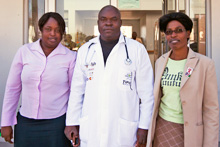
Getting the Right Health Workers in the Right Places: Namibia Applies WISN Tool
One step in improving the accessibility and quality of health care is to establish what numbers and types of health workers are needed to match the volume of services in particular facilities. In Namibia, where staffing norms had not been revised in over 10 years, CapacityPlus is assisting the Ministry of Health and Social Services to use the Workload Indicators of Staffing Need (WISN) tool to estimate workload requirements for doctors, nurses, and pharmacists in all 13 regions of the country.  Developed by the World Health Organization, WISN supports data-based decision-making in workforce planning and management by calculating the number and types of staff a health facility should need based on actual workload. Users of the tool define the components of the workload for the particular type of staff; set the time it takes a trained, well-motivated worker to perform components to acceptable professional standards; determine the time a health worker has available in one year to do his or her work, taking into account absences such as leave days; and identify available workload data. These staffing standards and service statistics are then entered into the WISN software for analysis.
Developed by the World Health Organization, WISN supports data-based decision-making in workforce planning and management by calculating the number and types of staff a health facility should need based on actual workload. Users of the tool define the components of the workload for the particular type of staff; set the time it takes a trained, well-motivated worker to perform components to acceptable professional standards; determine the time a health worker has available in one year to do his or her work, taking into account absences such as leave days; and identify available workload data. These staffing standards and service statistics are then entered into the WISN software for analysis.
The WISN application in Namibia revealed staff shortages—especially among medical officers and pharmacists—and inequities in staffing, particularly between health centers and clinics. Some clinics offer the same amount of care as large health centers, yet they may have only one or two nurses according to the current staffing norms. In addition, workload can vary widely at the same types of facilities. For example, in the case of two clinics—each staffed with one registered and one enrolled nurse—data revealed that one clinic had seen 13,541 outpatients in a year while the other had only seen 1,867.
Results from the WISN have informed numerous policy recommendations that will now be considered by the Ministry of Health and Social Services’ restructuring committee in the effort to address shortages and imbalances of staff in the country’s health facilities.
CapacityPlus’s overall work in Namibia focuses on technical assistance to the Ministry of Health and Social Services and faith-based organizations to enhance health workforce planning, budgeting, deployment, management, and retention of the health workforce, in support of health workers’ transition from donor funding to the government payroll.
Help CapacityPlus spread the word about strengthening the health workforce. Follow us on Twitter and like us on Facebook.
Related items:
Photo by Trevor Snapp, courtesy of IntraHealth International (Health workers at the Shanamutango HIV/AIDS Center at the Lutheran Medical Services Hospital in Namibia)


